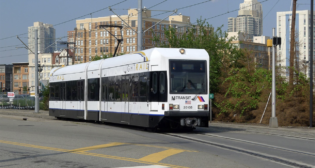
Innovation is the Antidote
Written by Alex Luna
The recent interesting piece titled “PSR: Can We Please Be Honest Here?” encapsulates perfectly what seems to be either the broad sentiment toward, or growing disillusionment, with the PSR operating strategy that now has been adopted by most railroads. But it does not seem to offer up any possible solutions to the seemingly systemic problems the author describes in great detail. So let me, as a young railroader who has set out to actually build tools that can hopefully help mitigate some of the chronic service problems our industry seems to suffer from, offer up a different, more optimistic perspective.
The chronic service problems this industry seems to yet again find itself struggling with are not caused by a lack of effort. I genuinely think that most rail operations management teams are doing their best to try to provide customers the best possible service they can with the tools and resources they have at their disposal. Instead, what we are experiencing is the result of limitations to the capabilities of the existing processes and technology that are used to plan and execute rail operations as railroads continue to push for ever greater operational efficiency. The only way to fix this problem is to innovate. Could there be potentially more nuanced reasons for the existing execution struggles that targeted innovation can help solve?
Railroading is Complex
Railroads are uniquely complex. In fact, I would argue that creating an operating plan for a railroad is one of the most complex supply chain optimization problems in existence. Consider the following simplified example: A rail network has five serving yards and nine available crews. We will define a “crew” in this example as a conductor and engineer operating a locomotive. On this network, three different point-to-point movements (“legs”) need to occur before a railcar arrives at its destination or interchange, and we need to decide how they will be performed.
It’s easiest to think about these “legs” as three different train “trips” that occur over a three-day period, so basically one train ride per day for the railcar. During this three-leg journey, we will need to use two intermediate serving yards at which to leave the railcar overnight so that the next crew can perform the next leg during the next day. So, for example, we could decide that the railcar that currently sits at an interchange and is waiting to begin this journey will be moved from that interchange to yard “A” for the first leg, then from yard “A” to yard “D” for the second, then from yard “D” to its destination at a customer’s facility for the third and final leg. One of the nine available crews needs to be assigned to perform each of these three leg movements as well.
One possible solution would be that we choose crew two to perform the first leg, then crew four to perform the second, and crew seven to perform the third and final movement. The question here is if we were to actually write down every single unique crew assignment and trip plan configuration that exists, what would be the total number of unique configurations that we could define? The answer: More than 2.954 sextillion (2.954 x 10^21). So three route legs raised to the five serving yard options multiplied by nine available crews, so 3^(5X9), or 3^45. This number is larger than the estimated number of grains of sand in the Sahara Desert (It has been estimated that there are 1.504 septillion (1.504 x 10^18) grains of sand in the Sahara Desert).
While this problem is simplified, and while real-world rail operational regulations and constraints actually reduce the total number of possible feasible configurations, the point of this example is to show that, while operational decisions may seem less complex given the constraints of rail track infrastructure and operating regulations, the design and execution of the work that will occur even on a small railroad each day is, at its core, an extremely complex combinatorial optimization problem.
Built With “Optimization” in Mind?
Given this complexity, let’s step back for a moment and think about a different question. Were the existing transaction management and work execution instruction deployment systems actually built with “optimization” in mind? Think about where the industry was many years ago when it began to adopt digital products to offload certain tasks to computerized systems. Consider specifically how the process of transforming a railcar movement transaction into work execution instructions essentially works today.
At transaction inception, the inputs from the waybill are “matched” to a normally pre-determined price that exists within the railroad’s contracts or tariffs. Simultaneously, in a separate system, when the waybill is received, the movement request for that railcar is “matched” to a trip plan that is based on the origin and destination locations listed in the waybill. This trip plan is generated by determining which “blocks” an individual railcar should be assigned to given a pre-determined set of available blocks that each pre-determined train will be moving from one station to another across the system. Then, the work execution instructions for the employees in the field are basically molded around whatever this train plan is that has been generated based on the blocking plan.
While this is a high-level summary and the nuts and bolts and complexity are far greater than just this one example, think about this process. Given how this process is set up, the existing technological connection between the request for movement of a customer’s railcars and a train being scheduled to occur does not ensure that the execution of that work will be optimal. The trip plans for railcars are basically pre-defined regardless of capacity availability or the network’s operational state. The optimization problem—that is, the generation of the optimal work execution instructions for the network given demand—instead is already pre-solved based on high-level annual or quarterly traffic forecast projections that often times are just guesses and are normally never accurate. The result is an operating plan that is not only essentially static, but also based on demand projections that likely will change. This means that the plan that is deployed is highly likely to be not only sub-optimal immediately but also extremely “fragile” given the inability of current systems to rapidly adjust to demand or operational state changes without human intervention.
I believe this to be one of the primary root causes of many service problems we face today as we push for even greater efficiency, for the demand for the services of railroads, i.e., demand in the industrial economy, and the operational states of railroads are both extremely dynamic, not static. This exact problem is what we at AlphaRail are aiming our targeted innovation efforts toward.
Consider a company that uses a truly dynamic “transportation management system” that has recently changed the world: Uber. When Uber’s “capacity” is needed, a customer submits a request and pays for that movement prior to the application sourcing capacity from its “network”—finding a driver in the area to execute the trip. Once the transaction is complete, Uber’s routing and scheduling algorithms generate work execution instructions for the Uber driver who accepts the trip. The entire process is automated. It is the definition of “optimal,” given that when an Uber driver is performing work, he or she is normally doing so only when the work he or she is performing is already paid for. Uber has essentially inverted the work request and execution instruction generation business process order when compared to railroads.
Uber’s business has structural characteristics that make it quite different from that of a railroad’s, and there are obviously lots of factors that impact a railroad’s ability to serve its customers that are not in the railroad’s control. But while it will not be a panacea for all operational ills, I think this specific feature of Uber’s ability to dynamically match transactions (demand) to work execution instructions is the holy grail for railroad efficiency, and could also be one potential antidote to the congestion problems railroads seem to suffer from.
While railroads are not solely responsible for the current service problems we have in our industry today, I am very optimistic that their severity can be eventually mitigated. Part of my optimism comes from actually working to build what we at AlphaRail think will be some of the requisite capabilities to enable this more Uber-like and dynamic work execution instruction generation capability. I have realized that the solutions seem within reach with the right resources, support, and people. My optimism also comes from seeing just how much railroads have been and seem to continue to want to invest in the infrastructure and technological capabilities that will be required to enable this “digital” and dynamic operational future. I hope railroads will continue to dedicate and even increase the amount of capital investment into this domain as well as more moonshot-type innovation initiatives.
Allocate The Capital
Paying for innovation is like buying call options: A limited amount of financial risk can result in dramatic payoffs. However, unlike call options, which can expire worthless, resulting in a total loss of initial investment and no value creation, every innovation initiative, regardless of the outcome, always gets you one step closer to actually finding the solution to the problem at which you initially aimed resources to solve. It makes the next attempt, if the first failed, more likely to succeed, because you know more about the problem and what is needed to solve it.
As owners and operators of a major part of the vascular system of the North American industrial economy, railroads most certainly have the resources to take small amounts of calculated risk in pursuit of innovative solutions to their current problems. To paraphrase a quote from Albert Einstein: We will not be able to solve our problems with the same type of thinking that we used to create them. This is especially accurate for our industry at the moment, and I believe that many of the other railroaders in this industry who, like myself, have experienced what it is like to be on the front lines of dealing with these service problems and their impact on our work objectives, would agree with me.
Amazon prides itself on being “Earth’s most customer-centric company,” and aiming capital investment at its processes and systems to realize this “operating strategy” has clearly worked. Railroads should be aiming at this objective as well. I am sure this perspective will generate quite a lot of pushback and resistance, and many will say it is not possible or not worth doing or pursuing yet. Let me be clear: I agree that improving rail service is no small simple task. But how much longer will railroads be able to rely on their economic moats to prevent them from needing to improve the quality of service they deliver to their customers?
The seemingly inevitable macroeconomic headwinds like electric vehicles reducing fuel consumption and a need for more reliable service to better-compete with trucks may begin buffeting the industry’s gates sooner than we think. Innovation is the most potent antidote for our current and incoming problems, and I see no reason to wait to begin working to build solutions that can potentially solve them. We at one point had to carve tunnels through mountain ranges basically by hand to solve our problems. Our current problems, while still challenging, seem a bit more solvable.

Alex Luna is Founder and CEO of AlphaRail, a Creative Destruction Lab graduate firm and a founding member firm of the United States Quantum Economic Development Consortium (QED-C). Alex holds an MBA from Vanderbilt University and serves on the Use Case Technology Advisory Committee for the QED-C.



